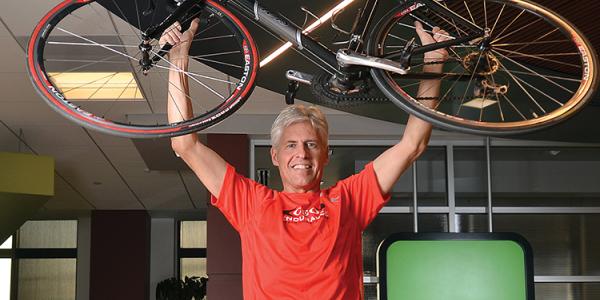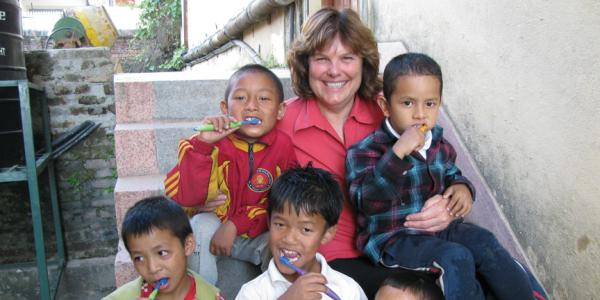
Finding chemo drugs that can kill cancer cells after radiation fuels professor Tin Tin Su’s cutting-edge research at CU-Boulder.
Cancer is the country’s No. 2 killer, following heart disease. Professor Tin Tin Su is working to develop powerful new tools in the fight against the deadly disease.
The next time you see a telltale cloud of fruit flies indicating decaying produce on your kitchen counter, you might want to say a little thank you before hauling the rotten stuff out to the compost.
Why? Because of the humble genus Drosophila, CU-Boulder professor Tin Tin Su of molecular, cellular and developmental biology is primed to develop powerful new tools in the fight against cancer.
The little flies are part of Su’s screening process to identify drugs that will work in combination with radiation to treat cancer. Because radiation doesn’t just kill cancer cells, it can be fatal to surrounding healthy tissue. So doctors must try to target dosages carefully.
But that raises the possibility that some cancerous cells are left behind.
“If there is any left behind, and you give it time to divide and multiply, the tumor will grow back,” says Su, co-founder of the company SuviCa, which completed an exclusive license agreement with CU for a drug screening technology to identify novel therapies for cancer.
Finding chemo drugs that can kill post-radiation cancer cells is critical and fuels Su’s research. Cancer is the country’s second leading killer, following heart disease. This year the American Cancer Society estimates that 1,638,910 people will be newly diagnosed with cancer and 577,190 people will die from it.
But how, exactly, does the little fruit fly figure into all this? Simply put, cancer occurs when cells are growing out of control. To stop out-of-control cells in their tracks, doctors must remove them via surgery or kill them with radiation or chemotherapy.
As it turns out, combinations of radiation and chemotherapy can be more effective than either treatment on its own. But not all combinations work. The success of the combination is based on synergy between agents, but the challenge is finding combinations that work, Su says.
“What radiation does is damage the DNA inside our cells,” she explains. “When a cell has damaged DNA, it tries to fix itself. A lot of times, depending on the dose of radiation, the cell can’t fix itself and will die.”
In terms of cancer treatment, that’s good. But there always remains the danger that some cancerous cells are left behind.
Enter Drosophila, which acts as a sort of stand-in for a cancerous tumor. Researchers zap targeted “packets” of cells in the fly larva with radiation. Then different agents are applied to see if they will control the growth of cells after exposure to radiation.

Drosophila fly
Now, here’s the counterintuitive bit: in this research you actually want the “patient” — the fly larva, a tumor analog — to die. If the larva lives to metamorphose into an adult fly, the “tumor” has survived, and the treatment hasn’t been effective.
“If it develops into a normal adult, that means it’s been able to compensate or replace the cells killed by radiation,” Su says.
With help from CU’s Technology Transfer Office, patent rights were applied for in 2006 and awarded in 2010. Su says the Drosophila screening process is several times more effective than any current system. Today’s drug screening systems use cells grown outside the body, typically in a plastic dish. The limitation of these systems is that you lose the context the cells are in when they are in an animal.
The advantage of the Drosophila system is the cells are in their natural environment. As a result the drug candidates Su finds have potential for more success on a tumor growing in the intact body of a patient.
“And fruit flies are cheap and easy to grow,” she says. “The whole experiment can be done in two weeks.”
The technology shows tremendous promise in sniffing out new cancer drugs, says Tom Smerdon of the Technology Transfer Office, who began working with Su about five years ago and helped SuviCa and CU work out a licensing agreement. Research done by faculty is the intellectual property of the university and so must be licensed for commercial use.
“As a drug discovery and a screening platform, this technology potentially could lead to the identification and development of drugs primarily effective for the treatment of cancer,” Smerdon says.
Su is chief science officer for SuviCa, which she started with CU graduate Scott Norviel (Econ’10) to help bring the technology to market. The company already has obtained two major grants, one from the state of Colorado’s business development program and the other from the Internal Revenue Service small-business program, as well as funding from private sources.
Su says her experience with starting the company has further convinced her CU is a natural environment for entrepreneurship in the biotech realm.
“There are many resources here, a lot of talent . . .” says Su who started her independent research career at CU-Boulder 13 years ago. “This is a top-notch place. We need to tap into all that talent and start making Colorado the go-to place for biotech.”
She hopes her work will have a lasting impact on cancer research.
“The hope of most of us [scientists] is that whatever we find will be useful either within our lifetimes or for another generation of scientists,” she says. “We all want to be useful in understanding human disease and erase suffering in some way. It’s very satisfying to come as close to that as possible during my scientific lifetime.”
Roughly 5 to 10 percent of inventions meet the criteria necessary to become start-up companies. At CU this translates to five to 10 startups per year depending on the number of invention disclosures the Technology Transfer Office receives in any given year.
Photo (top) courtesy Glenn Asakawa
Top things to know about CU-Boulder startups
A few successful startup companies
- Myogen, a Colorado-based biopharmaceutical company, was acquired by Gilead Sciences in 2006 for $2.5 billion.
- Dharmacon, which markets products and customized RNA-synthesis services to research laboratories, was acquired for $80 million in 2004 by Fisher Scientific. Fisher merged with Thermo Electron in 2006, and the company is called Thermo Fisher Scientific.
- Nobel prize winner Thomas Cech, CU-Boulder chemistry professor, discovered RNA could behave like an enzyme. His ribozyme discoveries were the basis for forming Ribozyme Pharmaceuticals Inc., later named Sirnal Therapeutics, which was acquired by Merck in 2006 for $1.1 billion.
Why encourage startups?
- Startups translate academic inventions into commercial goods and services
- A successful track record helps recruit and retain high-quality faculty.
- Startups are an engine for local economic development and job creation
Source: CU Technology Transfer Office






